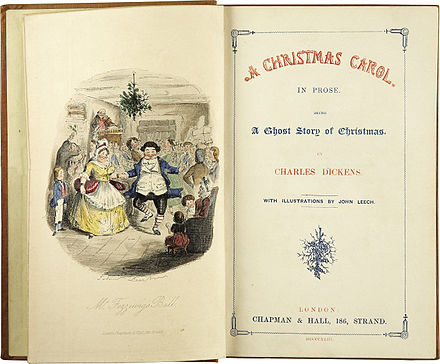This Christmastide, we explore the connections between the author of A Christmas Carol, Charles Dickens, and the cemetery records in the Deceased Online database
For many, Charles Dickens (1812-1870) is indelibly associated with Christmas. Besides the iconic A Christmas Carol (published in 1843), he also wrote the semi-autobiographical short story ‘A Christmas Tree’ (1850). Dickens loved the meaning and ritual of Christmas festivities. In later life, he enjoyed parties, and even in his poverty-stricken younger days, he always participated in the season. The ghosts in A Christmas Carol are believed to have been inspired by the stories told around the fire in his childhood Christmases that first inspired Dickens’ imagination to ‘hanker’ after the supernatural.
Although Dickens is buried in the Poet's Corner of Westminster Abbey, the burial records of many of his family and friends are found in the Deceased Online database.
In our Highgate Cemetery Collection from north London, you can find the burial register entry of Charles’ wife, Catherine "Kate" Thomson (Hogarth) Dickens (1815-1879).
Also in Highgate is Alfred Lamert Dickens (1822-1860), Charles' younger brother, died ten years before the author.
Scanned from 'Dickens and Daughter' by Gladys Storey Pub. by Frederick Muller Ltd (1939)
Charles' father, John Dickens (1785-1861), and mother, Elizabeth (Barrow) Dickens (1789-1863) are also buried in Highgate.
John Dickens was the model for Mr Micawber in David Copperfield while Elizabeth inspired Mrs Micawber and Nicholas Nickleby's Mrs Nickleby.
Perhaps the death that had the greatest effect on Dickens' work was that of his beloved sister-in-law, Mary Hogarth (1819-1837). It is said that she ‘haunted his dreams’ in the way that the ‘ghosts’ of those he had once cherished haunted the nights of Christmas Carol's protagonist, Ebenezer Scrooge.
Mary lies buried in Kensal Green Cemetery in West London. The cemetery was laid out in the emerging suburb of North Kensington in 1832, - just five years before she died.
In the same cemetery can be found Dickens' friend and fellow novelist, William Makepeace Thackeray (1811-63), who sadly died during the Christmas season.
The Vanity Fair author was so inspired by his friend Charles Dickens' Christmas writings that he wrote his own "Christmas Books", beginning with Mrs Perkin's Ball in 1847. By 1863, 52-year-old Thackeray had become ill and he was found in his bed on Christmas Eve of that year, it is believed, after suffering a stroke. Dickens attended the funeral on 30th December 1863.
For many, Charles Dickens (1812-1870) is indelibly associated with Christmas. Besides the iconic A Christmas Carol (published in 1843), he also wrote the semi-autobiographical short story ‘A Christmas Tree’ (1850). Dickens loved the meaning and ritual of Christmas festivities. In later life, he enjoyed parties, and even in his poverty-stricken younger days, he always participated in the season. The ghosts in A Christmas Carol are believed to have been inspired by the stories told around the fire in his childhood Christmases that first inspired Dickens’ imagination to ‘hanker’ after the supernatural.
Although Dickens is buried in the Poet's Corner of Westminster Abbey, the burial records of many of his family and friends are found in the Deceased Online database.
In our Highgate Cemetery Collection from north London, you can find the burial register entry of Charles’ wife, Catherine "Kate" Thomson (Hogarth) Dickens (1815-1879).
 |
| Catherine 'Kate' Thomson Dickens (née Hogarth) (19 May 1815 – 22 November 1879) [aged 64] was the wife of English novelist Charles Dickens, with whom he fathered 10 children. Stipple engraving by Edwin Roffe, after en:Daniel Maclise, and after en:John Jabez Edwin Mayall, published 1890 |
Scanned from 'Dickens and Daughter' by Gladys Storey Pub. by Frederick Muller Ltd (1939)
Charles' father, John Dickens (1785-1861), and mother, Elizabeth (Barrow) Dickens (1789-1863) are also buried in Highgate.
 |
| Portrait of Elizabeth Dickens (1789–1863) |
 |
| Portrait of John Dickens (1785–1851) |
Perhaps the death that had the greatest effect on Dickens' work was that of his beloved sister-in-law, Mary Hogarth (1819-1837). It is said that she ‘haunted his dreams’ in the way that the ‘ghosts’ of those he had once cherished haunted the nights of Christmas Carol's protagonist, Ebenezer Scrooge.
 |
| Portrait of Mary Scott Hogarth, aged 16 |
 |
| Burial register entry of Mary Ann Hogarth, showing her address of 48 Doughty Street, London |
 |
| Burial register entry of William Thackeray |




Comments
Post a Comment